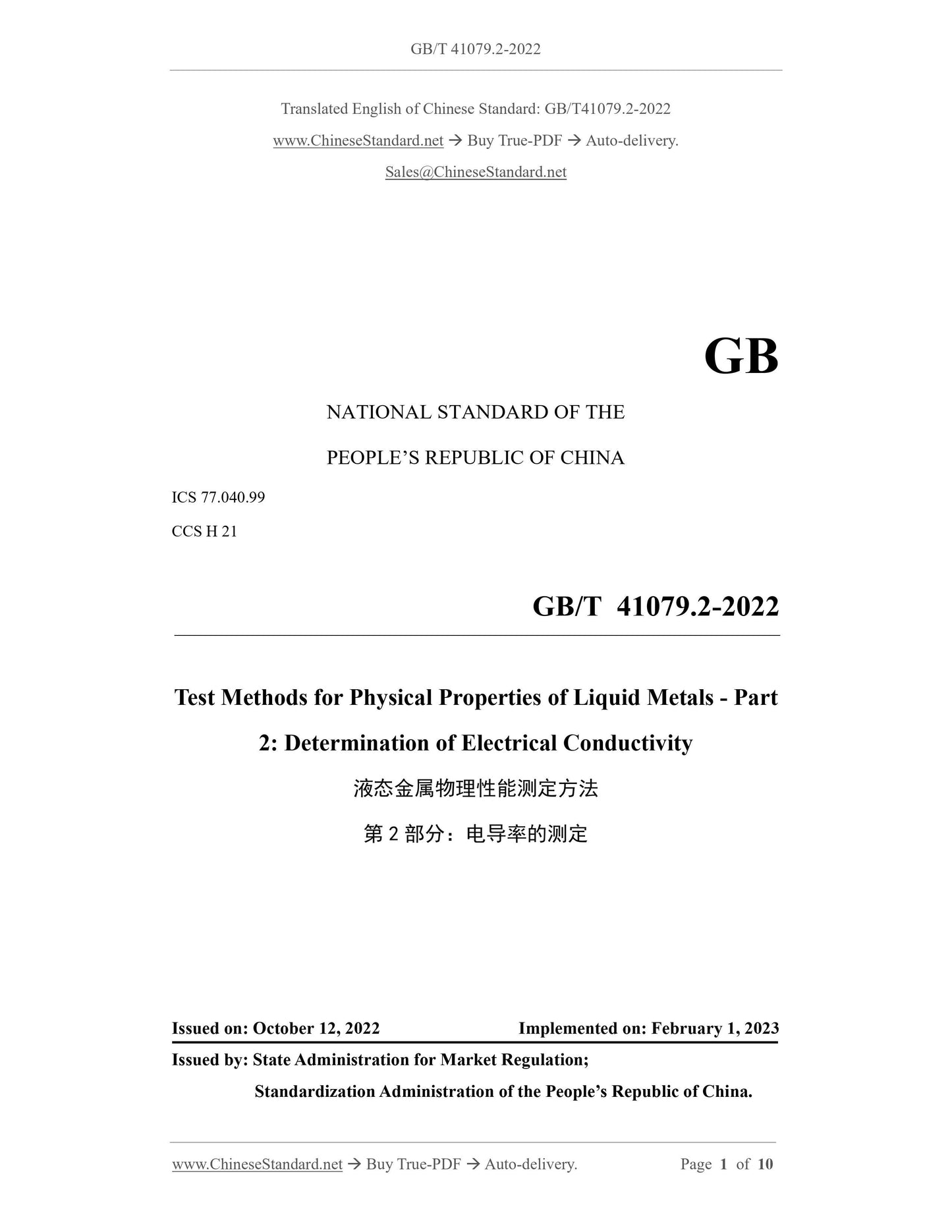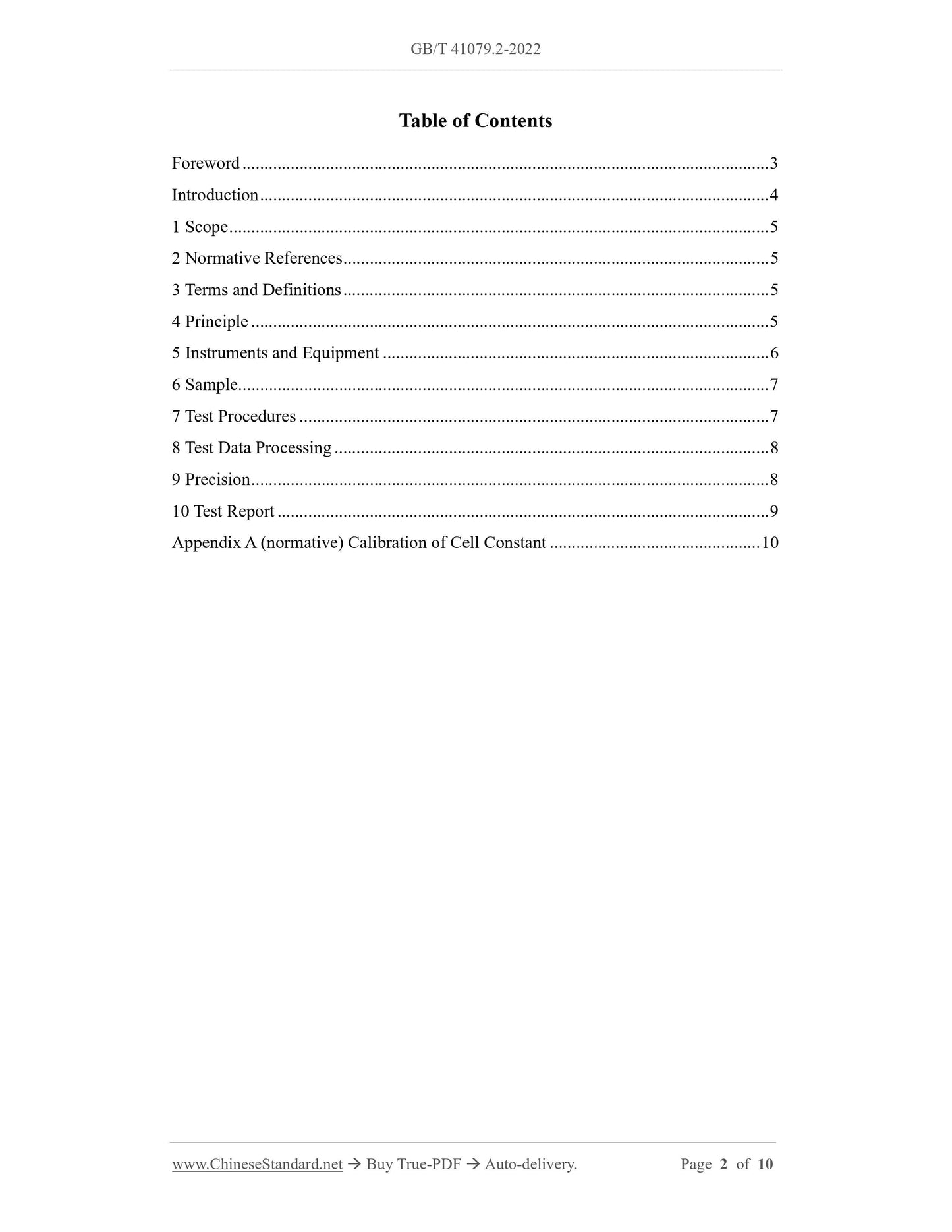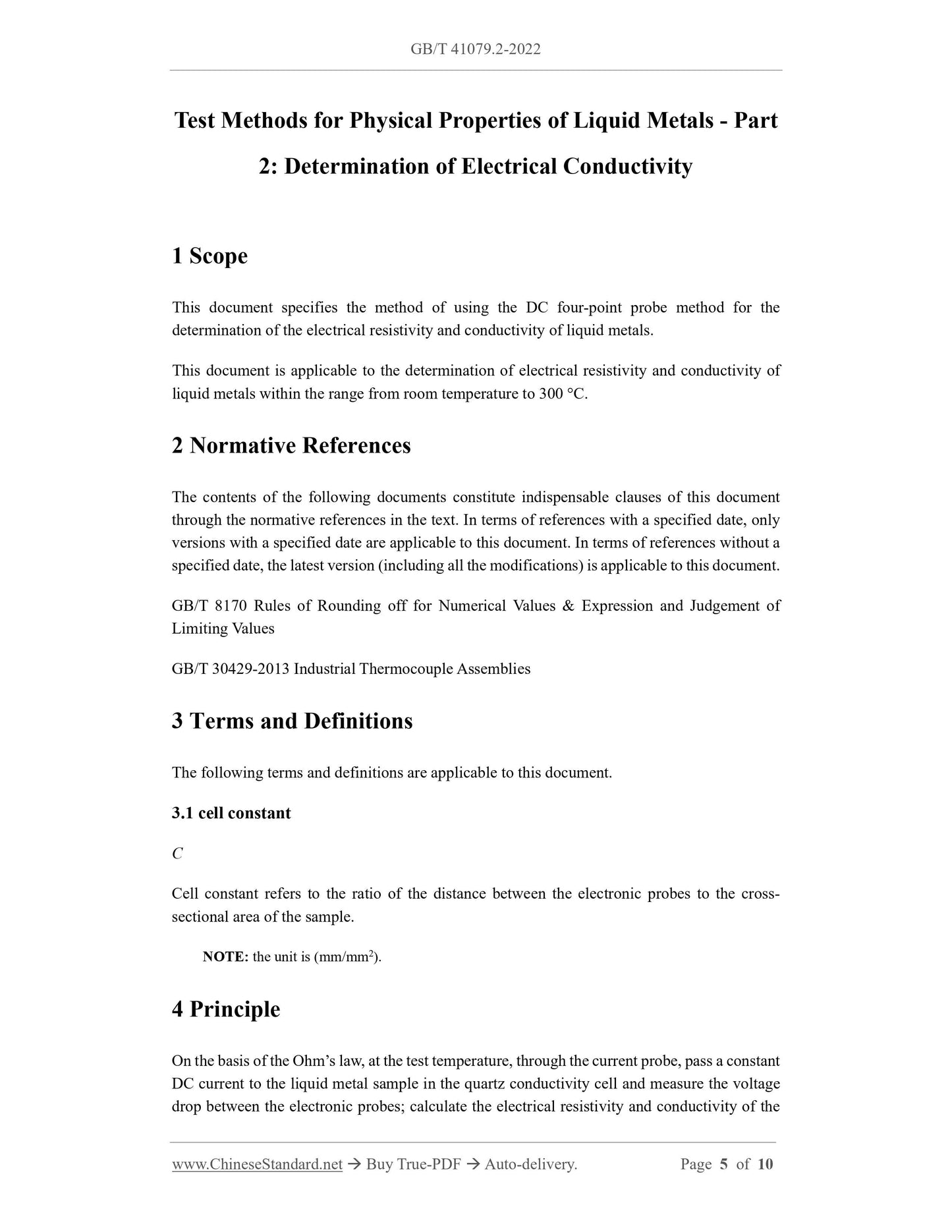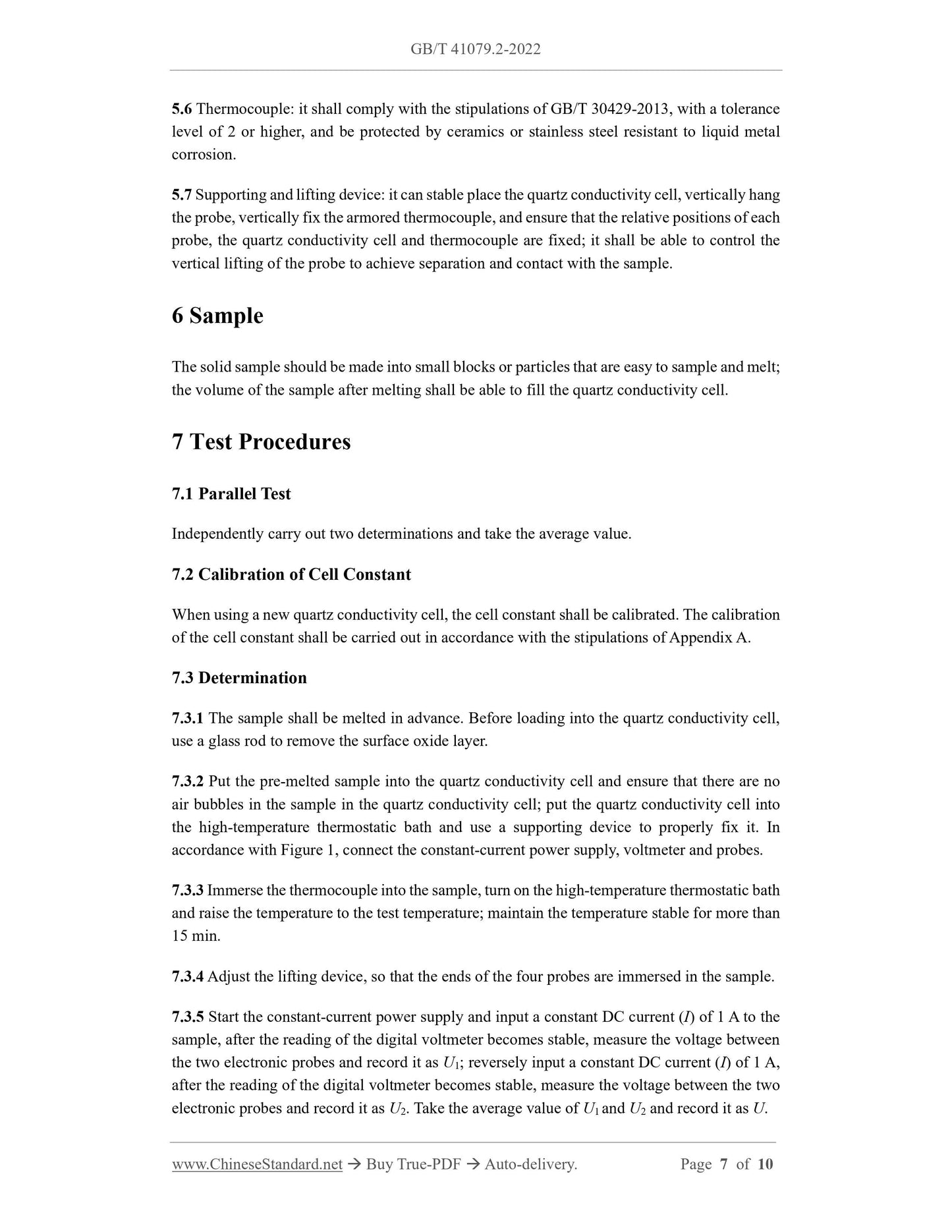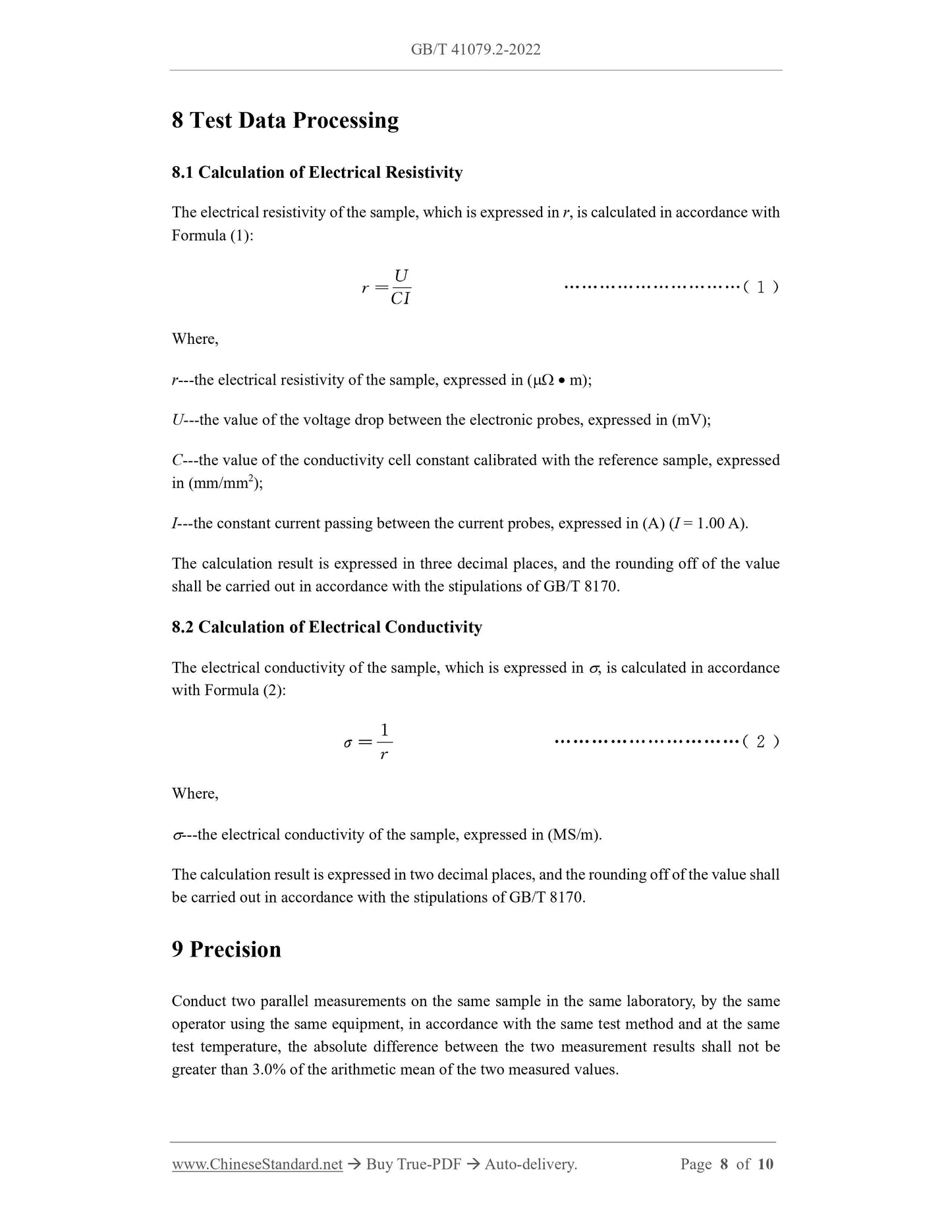1
/
of
5
www.ChineseStandard.us -- Field Test Asia Pte. Ltd.
GB/T 41079.2-2022 English PDF (GB/T41079.2-2022)
GB/T 41079.2-2022 English PDF (GB/T41079.2-2022)
Regular price
$125.00
Regular price
Sale price
$125.00
Unit price
/
per
Shipping calculated at checkout.
Couldn't load pickup availability
GB/T 41079.2-2022: Test methods for physical properties of liquid metals - Part 2: Determination of electrical conductivity
Delivery: 9 seconds. Download (& Email) true-PDF + Invoice.
Get Quotation: Click GB/T 41079.2-2022 (Self-service in 1-minute)
Historical versions (Master-website): GB/T 41079.2-2022
Preview True-PDF (Reload/Scroll-down if blank)
GB/T 41079.2-2022
GB
NATIONAL STANDARD OF THE
PEOPLE’S REPUBLIC OF CHINA
ICS 77.040.99
CCS H 21
Test Methods for Physical Properties of Liquid Metals - Part
2: Determination of Electrical Conductivity
ISSUED ON: OCTOBER 12, 2022
IMPLEMENTED ON: FEBRUARY 1, 2023
Issued by: State Administration for Market Regulation;
Standardization Administration of the People’s Republic of China.
Table of Contents
Foreword ... 3
Introduction ... 4
1 Scope ... 5
2 Normative References ... 5
3 Terms and Definitions ... 5
4 Principle ... 5
5 Instruments and Equipment ... 6
6 Sample ... 7
7 Test Procedures ... 7
8 Test Data Processing ... 8
9 Precision ... 8
10 Test Report ... 9
Appendix A (normative) Calibration of Cell Constant ... 10
Test Methods for Physical Properties of Liquid Metals - Part
2: Determination of Electrical Conductivity
1 Scope
This document specifies the method of using the DC four-point probe method for the
determination of the electrical resistivity and conductivity of liquid metals.
This document is applicable to the determination of electrical resistivity and conductivity of
liquid metals within the range from room temperature to 300 C.
2 Normative References
The contents of the following documents constitute indispensable clauses of this document
through the normative references in the text. In terms of references with a specified date, only
versions with a specified date are applicable to this document. In terms of references without a
specified date, the latest version (including all the modifications) is applicable to this document.
GB/T 8170 Rules of Rounding off for Numerical Values and Expression and Judgement of
Limiting Values
GB/T 30429-2013 Industrial Thermocouple Assemblies
3 Terms and Definitions
The following terms and definitions are applicable to this document.
3.1 cell constant
Cell constant refers to the ratio of the distance between the electronic probes to the cross-
sectional area of the sample.
NOTE: the unit is (mm/mm2).
4 Principle
On the basis of the Ohm’s law, at the test temperature, through the current probe, pass a constant
DC current to the liquid metal sample in the quartz conductivity cell and measure the voltage
drop between the electronic probes; calculate the electrical resistivity and conductivity of the
5.6 Thermocouple: it shall comply with the stipulations of GB/T 30429-2013, with a tolerance
level of 2 or higher, and be protected by ceramics or stainless steel resistant to liquid metal
corrosion.
5.7 Supporting and lifting device: it can stable place the quartz conductivity cell, vertically hang
the probe, vertically fix the armored thermocouple, and ensure that the relative positions of each
probe, the quartz conductivity cell and thermocouple are fixed; it shall be able to control the
vertical lifting of the probe to achieve separation and contact with the sample.
6 Sample
The solid sample should be made into small blocks or particles that are easy to sample and melt;
the volume of the sample after melting shall be able to fill the quartz conductivity cell.
7 Test Procedures
7.1 Parallel Test
Independently carry out two determinations and take the average value.
7.2 Calibration of Cell Constant
When using a new quartz conductivity cell, the cell constant shall be calibrated. The calibration
of the cell constant shall be carried out in accordance with the stipulations of Appendix A.
7.3 Determination
7.3.1 The sample shall be melted in advance. Before loading into the quartz conductivity cell,
use a glass rod to remove the surface oxide layer.
7.3.2 Put the pre-melted sample into the quartz conductivity cell and ensure that there are no
air bubbles in the sample in the quartz conductivity cell; put the quartz conductivity cell into
the high-temperature thermostatic bath and use a supporting device to properly fix it. In
accordance with Figure 1, connect the constant-current power supply, voltmeter and probes.
7.3.3 Immerse the thermocouple into the sample, turn on the high-temperature thermostatic bath
and raise the temperature to the test temperature; maintain the temperature stable for more than
15 min.
7.3.4 Adjust the lifting device, so that the ends of the four probes are immersed in the sample.
7.3.5 Start the constant-current power supply and input a constant DC current (I) of 1 A to the
sample, after the reading of the digital voltmeter becomes stable, measure the voltage between
the two electronic probes and record it as U1; reversely input a constant DC current (I) of 1 A,
after the reading of the digital voltmeter becomes stable, measure the voltage between the two
electronic probes and record it as U2. Take the average value of U1 and U2 and record it as U.
8 Test Data Processing
8.1 Calculation of Electrical Resistivity
The electrical resistivity of the sample, which is expressed in r, is calculated in accordance with
Formula (1):
Where,
r---the electrical resistivity of the sample, expressed in ( m);
U---the value of the voltage drop between the electronic probes, expressed in (mV);
C---the value of the conductivity cell constant calibrated with the reference sample, expressed
in (mm/mm2);
I---the constant current passing between the current probes, expressed in (A) (I = 1.00 A).
The calculation result is expressed in three decimal places, and the rounding off of the value
shall be carried out in accordance with the stipulations of GB/T 8170.
8.2 Calculation of Electrical Conductivity
The electrical conductivity of the sample, which is expressed in , is calculated in accordance
with Formula (2):
Where,
---the electrical conductivity of the sample, expressed in (MS/m).
The calculation result is expressed in two decimal places, and the rounding off of the value shall
be carried out in accordance with the stipulations of GB/T 8170.
9 Precision
Conduct two parallel measurements on the same sample in the same laboratory, by the same
operator using the same equipment, in accordance with the same test method and at the same
test temperature, the absolute difference between the two measurement results shall not be
greater than 3.0% of the arithmetic mean of the two measured values.
GB/T 41079.2-2022
GB
NATIONAL STANDARD OF THE
PEOPLE’S REPUBLIC OF CHINA
ICS 77.040.99
CCS H 21
Test Methods for Physical Properties of Liquid Metals - Part
2: Determination of Electrical Conductivity
ISSUED ON: OCTOBER 12, 2022
IMPLEMENTED ON: FEBRUARY 1, 2023
Issued by: State Administration for Market Regulation;
Standardization Administration of the People’s Republic of China.
Table of Contents
Foreword ... 3
Introduction ... 4
1 Scope ... 5
2 Normative References ... 5
3 Terms and Definitions ... 5
4 Principle ... 5
5 Instruments and Equipment ... 6
6 Sample ... 7
7 Test Procedures ... 7
8 Test Data Processing ... 8
9 Precision ... 8
10 Test Report ... 9
Appendix A (normative) Calibration of Cell Constant ... 10
Test Methods for Physical Properties of Liquid Metals - Part
2: Determination of Electrical Conductivity
1 Scope
This document specifies the method of using the DC four-point probe method for the
determination of the electrical resistivity and conductivity of liquid metals.
This document is applicable to the determination of electrical resistivity and conductivity of
liquid metals within the range from room temperature to 300 C.
2 Normative References
The contents of the following documents constitute indispensable clauses of this document
through the normative references in the text. In terms of references with a specified date, only
versions with a specified date are applicable to this document. In terms of references without a
specified date, the latest version (including all the modifications) is applicable to this document.
GB/T 8170 Rules of Rounding off for Numerical Values and Expression and Judgement of
Limiting Values
GB/T 30429-2013 Industrial Thermocouple Assemblies
3 Terms and Definitions
The following terms and definitions are applicable to this document.
3.1 cell constant
Cell constant refers to the ratio of the distance between the electronic probes to the cross-
sectional area of the sample.
NOTE: the unit is (mm/mm2).
4 Principle
On the basis of the Ohm’s law, at the test temperature, through the current probe, pass a constant
DC current to the liquid metal sample in the quartz conductivity cell and measure the voltage
drop between the electronic probes; calculate the electrical resistivity and conductivity of the
5.6 Thermocouple: it shall comply with the stipulations of GB/T 30429-2013, with a tolerance
level of 2 or higher, and be protected by ceramics or stainless steel resistant to liquid metal
corrosion.
5.7 Supporting and lifting device: it can stable place the quartz conductivity cell, vertically hang
the probe, vertically fix the armored thermocouple, and ensure that the relative positions of each
probe, the quartz conductivity cell and thermocouple are fixed; it shall be able to control the
vertical lifting of the probe to achieve separation and contact with the sample.
6 Sample
The solid sample should be made into small blocks or particles that are easy to sample and melt;
the volume of the sample after melting shall be able to fill the quartz conductivity cell.
7 Test Procedures
7.1 Parallel Test
Independently carry out two determinations and take the average value.
7.2 Calibration of Cell Constant
When using a new quartz conductivity cell, the cell constant shall be calibrated. The calibration
of the cell constant shall be carried out in accordance with the stipulations of Appendix A.
7.3 Determination
7.3.1 The sample shall be melted in advance. Before loading into the quartz conductivity cell,
use a glass rod to remove the surface oxide layer.
7.3.2 Put the pre-melted sample into the quartz conductivity cell and ensure that there are no
air bubbles in the sample in the quartz conductivity cell; put the quartz conductivity cell into
the high-temperature thermostatic bath and use a supporting device to properly fix it. In
accordance with Figure 1, connect the constant-current power supply, voltmeter and probes.
7.3.3 Immerse the thermocouple into the sample, turn on the high-temperature thermostatic bath
and raise the temperature to the test temperature; maintain the temperature stable for more than
15 min.
7.3.4 Adjust the lifting device, so that the ends of the four probes are immersed in the sample.
7.3.5 Start the constant-current power supply and input a constant DC current (I) of 1 A to the
sample, after the reading of the digital voltmeter becomes stable, measure the voltage between
the two electronic probes and record it as U1; reversely input a constant DC current (I) of 1 A,
after the reading of the digital voltmeter becomes stable, measure the voltage between the two
electronic probes and record it as U2. Take the average value of U1 and U2 and record it as U.
8 Test Data Processing
8.1 Calculation of Electrical Resistivity
The electrical resistivity of the sample, which is expressed in r, is calculated in accordance with
Formula (1):
Where,
r---the electrical resistivity of the sample, expressed in ( m);
U---the value of the voltage drop between the electronic probes, expressed in (mV);
C---the value of the conductivity cell constant calibrated with the reference sample, expressed
in (mm/mm2);
I---the constant current passing between the current probes, expressed in (A) (I = 1.00 A).
The calculation result is expressed in three decimal places, and the rounding off of the value
shall be carried out in accordance with the stipulations of GB/T 8170.
8.2 Calculation of Electrical Conductivity
The electrical conductivity of the sample, which is expressed in , is calculated in accordance
with Formula (2):
Where,
---the electrical conductivity of the sample, expressed in (MS/m).
The calculation result is expressed in two decimal places, and the rounding off of the value shall
be carried out in accordance with the stipulations of GB/T 8170.
9 Precision
Conduct two parallel measurements on the same sample in the same laboratory, by the same
operator using the same equipment, in accordance with the same test method and at the same
test temperature, the absolute difference between the two measurement results shall not be
greater than 3.0% of the arithmetic mean of the two measured values.
Delivery: 9 seconds. Download (& Email) true-PDF + Invoice.
Get Quotation: Click GB/T 41079.2-2022 (Self-service in 1-minute)
Historical versions (Master-website): GB/T 41079.2-2022
Preview True-PDF (Reload/Scroll-down if blank)
GB/T 41079.2-2022
GB
NATIONAL STANDARD OF THE
PEOPLE’S REPUBLIC OF CHINA
ICS 77.040.99
CCS H 21
Test Methods for Physical Properties of Liquid Metals - Part
2: Determination of Electrical Conductivity
ISSUED ON: OCTOBER 12, 2022
IMPLEMENTED ON: FEBRUARY 1, 2023
Issued by: State Administration for Market Regulation;
Standardization Administration of the People’s Republic of China.
Table of Contents
Foreword ... 3
Introduction ... 4
1 Scope ... 5
2 Normative References ... 5
3 Terms and Definitions ... 5
4 Principle ... 5
5 Instruments and Equipment ... 6
6 Sample ... 7
7 Test Procedures ... 7
8 Test Data Processing ... 8
9 Precision ... 8
10 Test Report ... 9
Appendix A (normative) Calibration of Cell Constant ... 10
Test Methods for Physical Properties of Liquid Metals - Part
2: Determination of Electrical Conductivity
1 Scope
This document specifies the method of using the DC four-point probe method for the
determination of the electrical resistivity and conductivity of liquid metals.
This document is applicable to the determination of electrical resistivity and conductivity of
liquid metals within the range from room temperature to 300 C.
2 Normative References
The contents of the following documents constitute indispensable clauses of this document
through the normative references in the text. In terms of references with a specified date, only
versions with a specified date are applicable to this document. In terms of references without a
specified date, the latest version (including all the modifications) is applicable to this document.
GB/T 8170 Rules of Rounding off for Numerical Values and Expression and Judgement of
Limiting Values
GB/T 30429-2013 Industrial Thermocouple Assemblies
3 Terms and Definitions
The following terms and definitions are applicable to this document.
3.1 cell constant
Cell constant refers to the ratio of the distance between the electronic probes to the cross-
sectional area of the sample.
NOTE: the unit is (mm/mm2).
4 Principle
On the basis of the Ohm’s law, at the test temperature, through the current probe, pass a constant
DC current to the liquid metal sample in the quartz conductivity cell and measure the voltage
drop between the electronic probes; calculate the electrical resistivity and conductivity of the
5.6 Thermocouple: it shall comply with the stipulations of GB/T 30429-2013, with a tolerance
level of 2 or higher, and be protected by ceramics or stainless steel resistant to liquid metal
corrosion.
5.7 Supporting and lifting device: it can stable place the quartz conductivity cell, vertically hang
the probe, vertically fix the armored thermocouple, and ensure that the relative positions of each
probe, the quartz conductivity cell and thermocouple are fixed; it shall be able to control the
vertical lifting of the probe to achieve separation and contact with the sample.
6 Sample
The solid sample should be made into small blocks or particles that are easy to sample and melt;
the volume of the sample after melting shall be able to fill the quartz conductivity cell.
7 Test Procedures
7.1 Parallel Test
Independently carry out two determinations and take the average value.
7.2 Calibration of Cell Constant
When using a new quartz conductivity cell, the cell constant shall be calibrated. The calibration
of the cell constant shall be carried out in accordance with the stipulations of Appendix A.
7.3 Determination
7.3.1 The sample shall be melted in advance. Before loading into the quartz conductivity cell,
use a glass rod to remove the surface oxide layer.
7.3.2 Put the pre-melted sample into the quartz conductivity cell and ensure that there are no
air bubbles in the sample in the quartz conductivity cell; put the quartz conductivity cell into
the high-temperature thermostatic bath and use a supporting device to properly fix it. In
accordance with Figure 1, connect the constant-current power supply, voltmeter and probes.
7.3.3 Immerse the thermocouple into the sample, turn on the high-temperature thermostatic bath
and raise the temperature to the test temperature; maintain the temperature stable for more than
15 min.
7.3.4 Adjust the lifting device, so that the ends of the four probes are immersed in the sample.
7.3.5 Start the constant-current power supply and input a constant DC current (I) of 1 A to the
sample, after the reading of the digital voltmeter becomes stable, measure the voltage between
the two electronic probes and record it as U1; reversely input a constant DC current (I) of 1 A,
after the reading of the digital voltmeter becomes stable, measure the voltage between the two
electronic probes and record it as U2. Take the average value of U1 and U2 and record it as U.
8 Test Data Processing
8.1 Calculation of Electrical Resistivity
The electrical resistivity of the sample, which is expressed in r, is calculated in accordance with
Formula (1):
Where,
r---the electrical resistivity of the sample, expressed in ( m);
U---the value of the voltage drop between the electronic probes, expressed in (mV);
C---the value of the conductivity cell constant calibrated with the reference sample, expressed
in (mm/mm2);
I---the constant current passing between the current probes, expressed in (A) (I = 1.00 A).
The calculation result is expressed in three decimal places, and the rounding off of the value
shall be carried out in accordance with the stipulations of GB/T 8170.
8.2 Calculation of Electrical Conductivity
The electrical conductivity of the sample, which is expressed in , is calculated in accordance
with Formula (2):
Where,
---the electrical conductivity of the sample, expressed in (MS/m).
The calculation result is expressed in two decimal places, and the rounding off of the value shall
be carried out in accordance with the stipulations of GB/T 8170.
9 Precision
Conduct two parallel measurements on the same sample in the same laboratory, by the same
operator using the same equipment, in accordance with the same test method and at the same
test temperature, the absolute difference between the two measurement results shall not be
greater than 3.0% of the arithmetic mean of the two measured values.
GB/T 41079.2-2022
GB
NATIONAL STANDARD OF THE
PEOPLE’S REPUBLIC OF CHINA
ICS 77.040.99
CCS H 21
Test Methods for Physical Properties of Liquid Metals - Part
2: Determination of Electrical Conductivity
ISSUED ON: OCTOBER 12, 2022
IMPLEMENTED ON: FEBRUARY 1, 2023
Issued by: State Administration for Market Regulation;
Standardization Administration of the People’s Republic of China.
Table of Contents
Foreword ... 3
Introduction ... 4
1 Scope ... 5
2 Normative References ... 5
3 Terms and Definitions ... 5
4 Principle ... 5
5 Instruments and Equipment ... 6
6 Sample ... 7
7 Test Procedures ... 7
8 Test Data Processing ... 8
9 Precision ... 8
10 Test Report ... 9
Appendix A (normative) Calibration of Cell Constant ... 10
Test Methods for Physical Properties of Liquid Metals - Part
2: Determination of Electrical Conductivity
1 Scope
This document specifies the method of using the DC four-point probe method for the
determination of the electrical resistivity and conductivity of liquid metals.
This document is applicable to the determination of electrical resistivity and conductivity of
liquid metals within the range from room temperature to 300 C.
2 Normative References
The contents of the following documents constitute indispensable clauses of this document
through the normative references in the text. In terms of references with a specified date, only
versions with a specified date are applicable to this document. In terms of references without a
specified date, the latest version (including all the modifications) is applicable to this document.
GB/T 8170 Rules of Rounding off for Numerical Values and Expression and Judgement of
Limiting Values
GB/T 30429-2013 Industrial Thermocouple Assemblies
3 Terms and Definitions
The following terms and definitions are applicable to this document.
3.1 cell constant
Cell constant refers to the ratio of the distance between the electronic probes to the cross-
sectional area of the sample.
NOTE: the unit is (mm/mm2).
4 Principle
On the basis of the Ohm’s law, at the test temperature, through the current probe, pass a constant
DC current to the liquid metal sample in the quartz conductivity cell and measure the voltage
drop between the electronic probes; calculate the electrical resistivity and conductivity of the
5.6 Thermocouple: it shall comply with the stipulations of GB/T 30429-2013, with a tolerance
level of 2 or higher, and be protected by ceramics or stainless steel resistant to liquid metal
corrosion.
5.7 Supporting and lifting device: it can stable place the quartz conductivity cell, vertically hang
the probe, vertically fix the armored thermocouple, and ensure that the relative positions of each
probe, the quartz conductivity cell and thermocouple are fixed; it shall be able to control the
vertical lifting of the probe to achieve separation and contact with the sample.
6 Sample
The solid sample should be made into small blocks or particles that are easy to sample and melt;
the volume of the sample after melting shall be able to fill the quartz conductivity cell.
7 Test Procedures
7.1 Parallel Test
Independently carry out two determinations and take the average value.
7.2 Calibration of Cell Constant
When using a new quartz conductivity cell, the cell constant shall be calibrated. The calibration
of the cell constant shall be carried out in accordance with the stipulations of Appendix A.
7.3 Determination
7.3.1 The sample shall be melted in advance. Before loading into the quartz conductivity cell,
use a glass rod to remove the surface oxide layer.
7.3.2 Put the pre-melted sample into the quartz conductivity cell and ensure that there are no
air bubbles in the sample in the quartz conductivity cell; put the quartz conductivity cell into
the high-temperature thermostatic bath and use a supporting device to properly fix it. In
accordance with Figure 1, connect the constant-current power supply, voltmeter and probes.
7.3.3 Immerse the thermocouple into the sample, turn on the high-temperature thermostatic bath
and raise the temperature to the test temperature; maintain the temperature stable for more than
15 min.
7.3.4 Adjust the lifting device, so that the ends of the four probes are immersed in the sample.
7.3.5 Start the constant-current power supply and input a constant DC current (I) of 1 A to the
sample, after the reading of the digital voltmeter becomes stable, measure the voltage between
the two electronic probes and record it as U1; reversely input a constant DC current (I) of 1 A,
after the reading of the digital voltmeter becomes stable, measure the voltage between the two
electronic probes and record it as U2. Take the average value of U1 and U2 and record it as U.
8 Test Data Processing
8.1 Calculation of Electrical Resistivity
The electrical resistivity of the sample, which is expressed in r, is calculated in accordance with
Formula (1):
Where,
r---the electrical resistivity of the sample, expressed in ( m);
U---the value of the voltage drop between the electronic probes, expressed in (mV);
C---the value of the conductivity cell constant calibrated with the reference sample, expressed
in (mm/mm2);
I---the constant current passing between the current probes, expressed in (A) (I = 1.00 A).
The calculation result is expressed in three decimal places, and the rounding off of the value
shall be carried out in accordance with the stipulations of GB/T 8170.
8.2 Calculation of Electrical Conductivity
The electrical conductivity of the sample, which is expressed in , is calculated in accordance
with Formula (2):
Where,
---the electrical conductivity of the sample, expressed in (MS/m).
The calculation result is expressed in two decimal places, and the rounding off of the value shall
be carried out in accordance with the stipulations of GB/T 8170.
9 Precision
Conduct two parallel measurements on the same sample in the same laboratory, by the same
operator using the same equipment, in accordance with the same test method and at the same
test temperature, the absolute difference between the two measurement results shall not be
greater than 3.0% of the arithmetic mean of the two measured values.
Share
